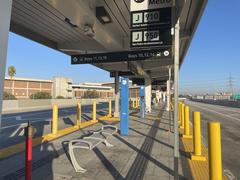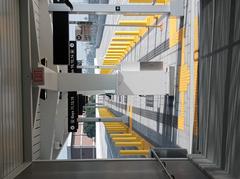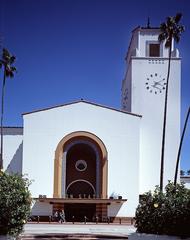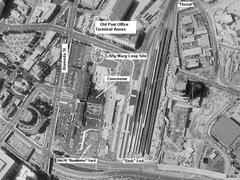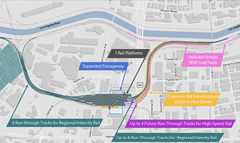
Los Angeles Union Station: Visiting Hours, Tickets, and Travel Guide (2025)
Date: 14/06/2025
Introduction
Los Angeles Union Station is much more than a transportation hub—it is a monumental gateway encapsulating the city’s historical, architectural, and cultural legacy. Opened in 1939 and known as the last great railway terminal built in the United States, Union Station unifies Los Angeles’ fragmented rail systems and stands as a testament to the city’s ambition and diversity (SAH Archipedia; Wikipedia). Its distinctive blend of Mission Revival, Spanish Colonial Revival, Art Deco, and Streamline Moderne styles reflects Southern California’s heritage and the modernist optimism of the early 20th century (Getty Iris; ARG Create).
Today, Union Station is the largest passenger rail terminal in the Western United States, serving approximately 110,000 passengers daily and integrating Amtrak, Metrolink, Metro Rail, and bus services (Union Station LA; Railway Traveller). Beyond transit, it functions as a vibrant cultural venue—hosting events, art exhibitions, and performances that highlight LA’s diversity and creativity (unionstationla.com). This guide provides you with essential information for your visit, including opening hours, ticketing options, accessibility, guided tours, travel tips, and nearby attractions.
Table of Contents
- Historical Overview
- Architecture and Signature Features
- Visiting Information
- Travel Tips
- Nearby Attractions
- Accessibility and Amenities
- Preservation and Restoration
- Cultural Programming and Community Engagement
- Frequently Asked Questions (FAQs)
- Conclusion
- References
Historical Overview
The Need for a Union Station
In the early 20th century, Los Angeles was served by three separate passenger terminals, leading to inefficiencies and congestion (SAH Archipedia). The push for a unified terminal began in the 1910s, culminating in a 1926 citywide ballot approving its construction. The chosen site was the heart of old Chinatown, displacing many residents and overlaying historic Tongva land (Wikipedia; Segregation By Design).
Construction and Opening
Construction began in 1936 during the Great Depression, funded by the three major railroads at a cost of $11 million (over $220 million today). The station officially opened in May 1939, celebrated as an architectural and civic milestone (Daytrippen).
Wartime and Postwar Years
Union Station played a critical role during World War II, handling up to 100 trains daily for troop movements (Travel in USA). After the war, the rise of automobiles and air travel caused a decline in rail ridership.
Preservation and Modern Revitalization
In 1972, Union Station was designated a Los Angeles Historic-Cultural Monument, and in 1980 it joined the National Register of Historic Places (Wikipedia). Metro’s acquisition in 2011 led to extensive restoration and modernization, establishing the station as a multimodal transit hub (Union Station LA).
Union Station Today
Union Station now integrates Amtrak, Metrolink, Metro Rail, and local bus services. It is also a cultural hub, hosting major events like the 93rd Academy Awards, art installations, and public festivals (unionstationla.com; Discover Walks). Plans for high-speed rail integration and further improvements are ongoing (SAH Archipedia).
Architecture and Signature Features
Union Station’s architecture is a harmonious blend of Mission Revival, Spanish Colonial Revival, and Streamline Moderne (Art Deco) styles, designed by Parkinson & Parkinson (Getty Iris; ARG Create).
Key Features
- Grand Waiting Room: Boasts 40-foot ceilings with hand-stenciled beams, inlaid marble and terra cotta floors, and original leather seating.
- Ticket Concourse: Features Art Deco design, with restored brass-framed ticket windows and geometric tilework.
- Clock Tower: The iconic tower serves as a city landmark, blending Moderne and Spanish Colonial elements.
- Outdoor Patios and Courtyards: Landscaped North and South Patios provide open-air relaxation and a distinctive Southern California ambiance.
- Decorative Tilework: Unique terra cotta tiles, especially in the South Patio, highlight the station’s craftsmanship (Getty Iris; Adventures of a Carry On).
Visiting Information
Visiting Hours
- General Hours: Daily, 5:00 AM – 12:00 AM. Public areas are accessible during these hours; some amenities and services may vary (Union Station LA).
- Ticketing Counters: Open 6:00 AM – 10:00 PM.
- Metro Rail platforms: Accessible during Metro operating hours (generally early morning to midnight).
- Dining and Shops: Hours vary by vendor. Check the official website for details.
Tickets and Transit Access
- Amtrak & Metrolink: Purchase online, at station kiosks, or via mobile apps.
- Metro Rail & Bus: TAP cards available at vending machines throughout the station.
- Self-guided visits: Free; there is no admission fee to explore public spaces (ExperienceFirst).
Guided Tours
- Architecture & History Tours: Offered periodically by local organizations, including the Los Angeles Conservancy. Check Union Station Tours for current schedules.
Travel Tips
- Arrive Early: Allow extra time to enjoy the station’s architecture and art.
- Use Public Transit: Parking is limited and can fill quickly; Metro connections are convenient.
- Check Schedules: Consult Amtrak, Metrolink, and Metro websites or the Audiala app for real-time updates.
- Photography: Early morning or late afternoon offers the best light and fewer crowds.
Nearby Attractions
Union Station’s central location places you steps from some of LA’s most historic and vibrant districts:
- Olvera Street: Lively Mexican marketplace and historic heart of LA.
- El Pueblo de Los Angeles Historic Monument: Museums and cultural events.
- Chinatown: Dining, shopping, and cultural experiences to the north.
- Little Tokyo: Japanese-American culture, museums, and cuisine to the south.
- Grand Central Market & Walt Disney Concert Hall: Short walk or Metro ride away for food and arts (ExperienceFirst; Latourist).
Accessibility and Amenities
- Full Accessibility: Ramps, elevators, accessible restrooms, and tactile paving throughout.
- Assistance: Available at the customer service desk.
- Amenities: Free Wi-Fi, retail shops, dining, clean restrooms, and comfortable waiting areas.
- Security: Visible presence and well-lit public spaces for safety.
Preservation and Restoration
Union Station’s architectural integrity has been preserved through significant restoration projects, including cleaning and repairing original metalwork, wood finishes, and tile (ARG Create). Ongoing stewardship by Metro and recognition from the Los Angeles Conservancy ensure that this living civic monument remains both functional and beautiful (laconservancy.org).
Cultural Programming and Community Engagement
Union Station regularly hosts art exhibitions, music performances, and cultural festivals, making it a vibrant community gathering place (unionstationla.com). Notable programs include Metro Art Presents and the annual Train Festival, as well as temporary art installations in the Passageway Art Gallery.
Frequently Asked Questions (FAQs)
Q: What are Union Station’s visiting hours?
A: General access is from 5:00 AM to 12:00 AM daily. Some services and amenities may have different hours.
Q: Where can I buy tickets?
A: Tickets for Amtrak or Metrolink are available online, at kiosks, or ticket counters. Metro Rail and bus tickets use the TAP card system, available at vending machines.
Q: Is the station accessible for people with disabilities?
A: Yes, Union Station is fully wheelchair accessible, with ramps, elevators, and accessible restrooms.
Q: Are guided tours available?
A: Guided architectural and history tours are offered periodically; check Union Station Tours or the Los Angeles Conservancy for schedules.
Q: What are some nearby attractions?
A: Olvera Street, El Pueblo Historic Monument, Chinatown, Little Tokyo, and Grand Central Market are all within walking distance.
Conclusion
Los Angeles Union Station stands at the crossroads of history, architecture, and urban life. Its unique blend of styles, civic significance, and ongoing restoration efforts make it not only a vital transportation hub but also a living monument to the city’s past and future. Whether you’re a commuter, tourist, or history enthusiast, a visit to Union Station promises a memorable experience of architectural grandeur and cultural vibrancy.
Before you visit, check the official website and download the Audiala app for real-time updates, tickets, and special offers. Explore the station, nearby neighborhoods, and immerse yourself in the story of Los Angeles.
References
- SAH Archipedia
- Wikipedia
- Discover Walks
- Getty Iris
- ARG Create
- Union Station LA
- Union Station LA Happenings
- Los Angeles Conservancy
- ExperienceFirst
- e-a-a.com
- Travel in USA
- Railway Traveller
- Segregation By Design
- Go City
- Latourist
- Grounded Life Travel
- Discover Los Angeles
- Daytrippen
- The Evolista
- Audiala

